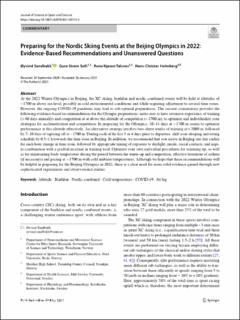| dc.description.abstract | At the 2022 Winter Olympics in Beijing, the XC skiing, biathlon and nordic combined events will be held at altitudes of ~ 1700 m above sea level, possibly in cold environmental conditions and while requiring adjustment to several time zones. However, the ongoing COVID-19 pandemic may lead to sub-optimal preparations. The current commentary provides the following evidence-based recommendations for the Olympic preparations: make sure to have extensive experience of training (> 60 days annually) and competition at or above the altitude of competition (~ 1700 m), to optimize and individualize your strategies for acclimatization and competition. In preparing for the Olympics, 10–14 days at ~ 1700 m seems to optimize performance at this altitude effectively. An alternative strategy involves two–three weeks of training at > 2000 m, followed by 7–10 days of tapering off at ~ 1700 m. During each of the last 3 or 4 days prior to departure, shift your sleeping and eating schedule by 0.5–1 h towards the time zone in Beijing. In addition, we recommend that you arrive in Beijing one day earlier for each hour change in time zone, followed by appropriate timing of exposure to daylight, meals, social contacts, and naps, in combination with a gradual increase in training load. Optimize your own individual procedures for warming-up, as well as for maintaining body temperature during the period between the warm-up and competition, effective treatment of asthma (if necessary) and pacing at ~ 1700 m with cold ambient temperatures. Although we hope that these recommendations will be helpful in preparing for the Beijing Olympics in 2022, there is a clear need for more solid evidence gained through new sophisticated experiments and observational studies. | en_US |

